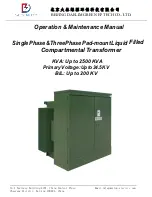
14
iNET Series Reference Manual
05-2806A01, Rev. H
station antenna. A detailed discussion on the effects of terrain is given
in Section 4.1.2,
Site Selection
(beginning on Page 131)
1.4.2 Protected Network Operation using Multiple
Access Points
Although GE MDS transceivers have a very robust design and have
undergone intensive testing before being shipped, it is possible for iso-
lated failures to occur. In mission-critical applications, down time can
be virtually eliminated by using some, or all, of the following configu-
rations:
In a point-to-multipoint scenario, the Access Point services multiple
remotes. A problem in the Access Point will have an effect on all
remotes, since none will have access to the network. When operation of
the network does not tolerate any down time, it is possible to set up a
protected configuration for the Access Point to greatly reduce the possi-
bility of this occurrence.
Two or more Access Points can be configured with the same Network
Name and kept active simultaneously, each with its own independent
antenna. In this scenario, Remotes will associate with either one of the
available Access Points. In case of a failure of one of the AP’s the
Remotes will quickly associate with another of the remaining Access
Points re-establishing connectivity to the end devices.
The Access Points are unaware of the existence of the other AP’s.
Because the hopping algorithm uses
both
the Network Name
and
the
Wireless MAC address of the AP to generate the hopping pattern, mul-
tiple AP’s can coexist—even if they use the same network name. The
collocated AP’s will be using different hopping patterns and frequencies
the great majority of the time. Although some data collisions will occur,
the wireless-MAC is built to tolerate and recover from such occurrences
with minimal degradation.
1.4.3 Collocating Multiple Radio Networks
Many networks can operate in relatively close physical proximity to one
another provided reasonable measures are taken to assure the radio
signal of one Access Point is not directed at the antenna of the second
Access Point
.
The Network Name and the association process
The Network Name is the foundation for building individual radio net-
works. It is part of a beacon signal broadcast by the Access Point (AP)
to any Remote units with the same Network Name. Remotes that join the
network are referred to as being “associated” with the Access Point unit.
Multiple APs with the same Network Name should be used with care.
Using the same Network Name in multiple APs may result in Remotes
Содержание MDS iNET-II 900
Страница 12: ...2 iNET Series Reference Manual 05 2806A01 Rev H...
Страница 32: ...22 iNET Series Reference Manual 05 2806A01 Rev H...
Страница 122: ...112 iNET Series Reference Manual 05 2806A01 Rev H...
Страница 124: ...114 iNET Series Reference Manual 05 2806A01 Rev H...
Страница 136: ...126 iNET Series Reference Manual 05 2806A01 Rev H...
Страница 138: ...128 iNET Series Reference Manual 05 2806A01 Rev H...
Страница 162: ...152 iNET Series Reference Manual 05 2806A01 Rev H...
Страница 164: ...154 iNET Series Reference Manual 05 2806A01 Rev H...
Страница 174: ...164 iNET Series Reference Manual 05 2806A01 Rev H...
Страница 182: ...172 iNET Series Reference Manual 05 2806A01 Rev H...
Страница 190: ...GE MDS LLC Rochester NY 14620 General Business 1 585 242 9600 FAX 1 585 242 9620 Web www GEmds com 175 Science Parkway...
















































